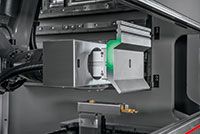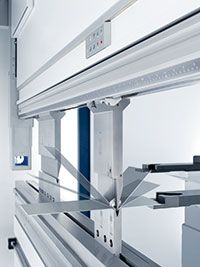by Kip Hanson
Is your press brake tooling holding you back?
Although press brakes themselves haven’t changed all that much over the past decade or so, the systems and accessories needed to operate them have. Quick-change tooling is increasingly popular, shortening setup times and clearing the way for robotic tool changers. With this has come software for tracking, scheduling, and maintaining tools, RFID tagging and similarly sophisticated methods of tool identification, and entirely new types of tooling designed to make press brakes even more flexible. Here are some insights from three press brake experts, along with a little advice on how to maximize your shop’s bending operations.
 Doctor Bender
Doctor Bender
Paul LeTang, product manager of press brakes/tooling at Bystronic Inc., notes that one of the biggest changes in recent years has been a shift away from the traditional centralized tool crib in favour of each machine having its own set of tools. “With lot sizes falling, many of our customers need to set up multiple jobs each day, and most are willing to invest in additional tooling as a means of reducing downtime,” he says.
Because of this, the hand wringing over tool interchangeability that was once so common has become much less important—in fact, some shops prefer that tools not be interchangeable. Each operator is now responsible for his or her own tools, increasing accountability, and there’s no chance of old tools ending up in a new machine. And of course, machine-specific tooling also eliminates the time wasted on walking back and forth to the tool crib, as well as the long accepted shimming, tweaking, and fine tuning of the tools once tools are actually in the machine.
Perhaps the biggest challenge in this scenario is what to do with a special tool—which machine gets it, and how does everyone know where it is without peering inside each machine’s tool cabinet or carousel? That’s where planning and scheduling software comes in, which in Bystronic’s case is its BySoft 7 Plant Manager. As with competing software packages and indeed most ERP systems, this makes it possible to identify each press brake and piece of press brake tooling together with their locations on the production floor, and optimize the use of these assets accordingly. The problem is, very few shops are currently taking advantage of it.
“Most leave any sort of machine scheduling and optimization up to the operator,” says LeTang. “He or she will come in each morning, evaluate what’s on the floor waiting to be processed, and then figure out the most efficient way to stage it all. But as you’re probably aware, this level of skill and experience is becoming harder to come by. That’s why I predict more and more fab shops will increase their reliance on scheduling systems and other types of advanced software in the near future, to help augment our shrinking labour force.”
An abundance of automation
With each press brake home to its own set of tooling, the question then becomes, what is the most effective way to get tooling into and out of the machine? Bystronic has addressed this need with its Xpert Tool Changer, a robot that is mounted to the back of the machine and changes tools “much like a machine operator would.” Aside from greater consistency and speed, automated tool changers serve to remedy the problem just mentioned—a shortage of skilled operators.
“It’s not too difficult to find someone able to load and unload parts, but ask most shop people to swap out some tools and they’ll head for the hills,” says LeTang. “An automated tool changer (ATC) eliminates one of the more intimidating parts of press brake operation. And if that’s still too much, we’ll be releasing our Xpert Bender Cell later this fall, which automates the part handling aspect as well.”
However the tools are loaded, identifying them is a big consideration. Bystronic uses an integrated vision system to scan tool lengths and profiles when placing them into the machine. Amada America Inc. relies on QR codes that the operator will scan during setup, “whether in a stand-alone brake or on the ATC,” says Scott Ottens, bending product manager for Amada.
Whether manual or automatic, hydraulic clamping is typically used to grip tools in the machine—once the operator or robot places each tool into its correct location, a switch is flipped or command given and everything is instantly locked in place. Between this, the tooling’s quick-change capabilities and its tool identification and positioning (TIPS) technology, setups are now easier and faster than ever before.
Ottens points to another use of integrated tool identification, one that is just beginning to pick up steam in North America. “By uniquely identifying each tool with a QR code or RFID tag, it then becomes possible to keep better track of it, answering questions like how many bends it’s made, what jobs it was used on, or when it was last maintained,” says Ottens. “I’d say that we as a country don’t do a great job of tool maintenance, and this kind of Industry 4.0 functionality should help improve that situation.”
Staying put
Ottens is in complete agreement on the industry’s move towards decentralized tool storage. “Keeping tools in a cabinet alongside the brake is a much better scenario,” he says. “Anytime you have the operator leave the machine and walk somewhere to get something, nine out of ten times he’ll get distracted by something along the way and then the machine sits idle. Decentralized storage eliminates that. That’s also one of the huge advantages of an ATC, in that the operator never really leaves the machine—as long as material and jobs come to him, he can just keep rolling through one job right after another.”
Ottens is also a big fan of fixed height (Amada Fixed Height- AFH) tooling, a relatively new offering for Amada. “On the punch side, everything is built to the same height, whether it’s a gooseneck profile, sash, straight or acute,” says Ottens. “That’s been available for the past year or two. And then on the die side, we’ve standardized the effective V-height, so you might have an offset tool in the machine, a radiused bend, you could be hemming—all these tools can go in the brake at the same time, and when the ram comes down, they all bottom out together. This lets shops develop common tool layouts to bend a large variety of parts, or bend different material thicknesses without worrying about shimming. Properly applied, it can be a huge timesaver.”
Here again, shops everywhere are focused on set up time reduction—productivity’s no longer about how many parts were made today, it’s about how many jobs were setup and completed. Yesterday’s batch processing mentality has given way to today’s lean thinking, explains Ottens, with an emphasis on lower inventory levels, reduced work-in-process, maximum machine uptime, and improved cash flow by getting parts out the door quickly. “It’s about building what you need right now, in the most efficient way possible,” he says.
 Roll me away
Roll me away
LeTang and Ottens alike mentioned several new styles of press brake tooling they’ve made available recently, as did Corey Miron, tooling technician at TRUMPF Inc. The first of these—which in TRUMPF’s case is called Polymer V-Strip KVL—use a set of replaceable liners made of nylon or similar plastic to eliminate the scratching and gouging that can occur to the workpiece as it’s dragged downwards into the die.
“KVL is a lower cost alternative to our roll bend tooling, which uses a pair of rotating jaws that support each side of the part as it slides into the opening,” he says. “Aside from eliminating wear and tear on the die and workpiece, roll bending also helps to reduce the amount of material stretching near the bend line, in turn reducing deformation of nearby holes and slots.”
Like Bystronic and Amada, TRUMPF is also paying close attention to part accuracy, and one of the best ways to achieve this is through in-process bend angle measurement. To this end, Miron says the company’s new “angle controlled bending” (ACB) tooling uses a pair of sensors inside the punch to measure the bend, and then sends this data wirelessly or via an attached power strip to the machine control, automatically adjusting the stroke as needed to precisely hit the desired angle.
Whatever the tooling brand, no matter whose logo is on the front of the machine, each of the experts interviewed for this article named regular tooling maintenance as one of the more important—and often overlooked—aspects of press brake operation. Always wipe tooling down after each use to prevent galling, Miron suggests, and apply a light film of oil afterwards to avoid corrosion. Then, store it in a non-contact, humidity free environment. And be sure to follow bending force guidelines, he says, as excessive force creates additional wear on the tool’s working edges, resulting in a shorter lifespan.
“You should try to minimize the amount of tooling needed wherever possible,” adds Miron. “Anyone that designs and builds their own products should try to standardize their inside bend radii. If not, using a standard punch radius and manipulating the die width to achieve the desired inside bend radius helps to reduce a shop’s overall tooling spend. Finally, always utilize air bending, which is a great way to achieve angles ranging from 179° down to 30° using a single set of tools.” SMT
